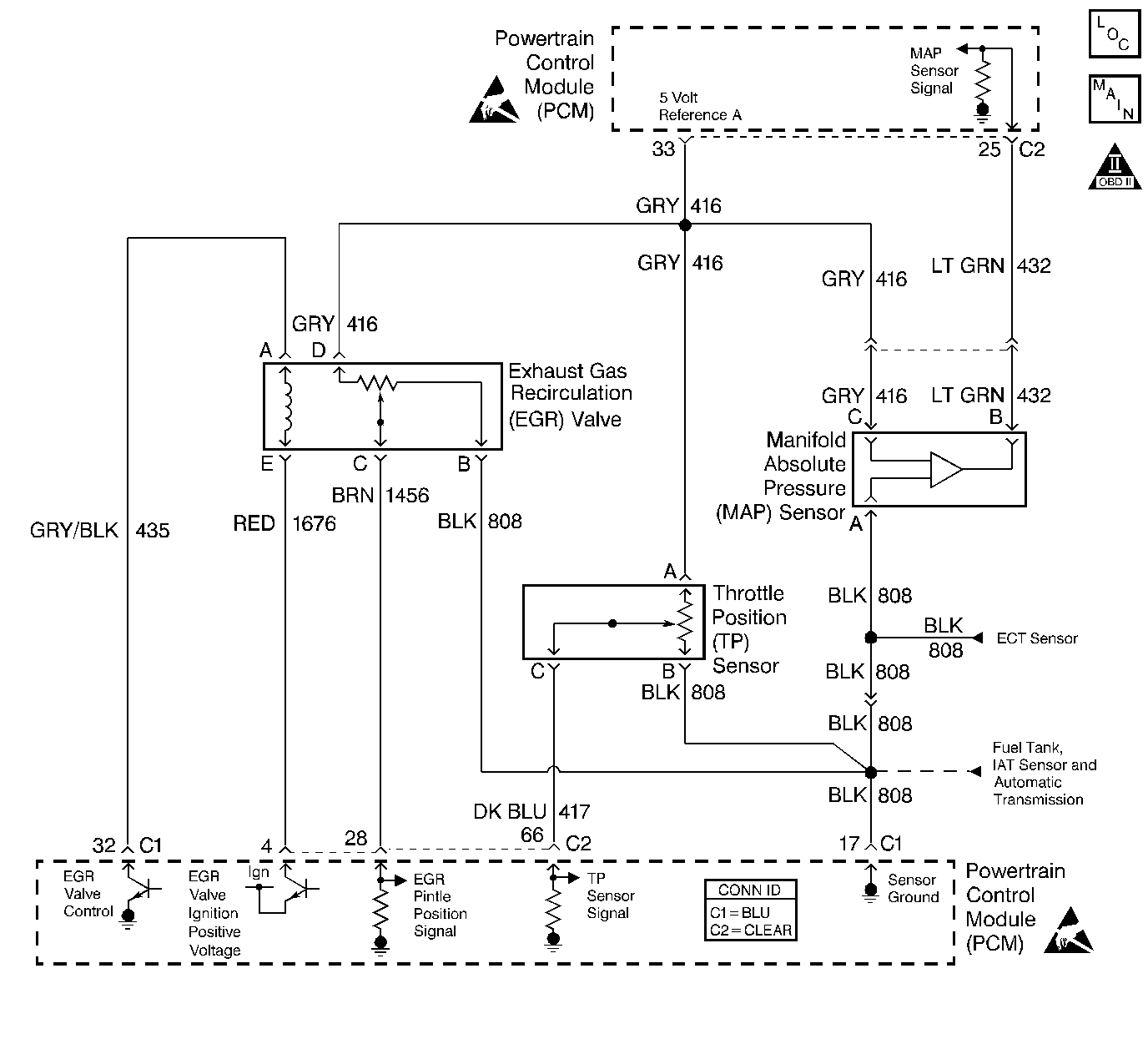
Circuit Description
The Throttle Position (TP) Sensor circuit provides a voltage signal that changes relative to throttle blade angle. The signal voltage will vary from below 1.0 volt at closed throttle to above 4.0 volts at Wide Open Throttle (WOT). If the PCM detects an excessively low TP Sensor voltage, DTC P0122 will be set.
Conditions for Running the DTC
The ignition is on.
Conditions for Setting the DTC
| • | TP sensor signal voltage is less than 0.1 volts. |
| • | The above condition is present for at least 10 seconds. |
Action Taken When the DTC Sets
| • | The PCM will illuminate the malfunction indicator lamp (MIL) during the second consecutive trip in which the diagnostic test has been run and failed. |
| • | The PCM will store conditions which were present when the DTC set as Freeze Frame and Failure Records data. |
Conditions for Clearing the MIL/DTC
| • | The PCM will turn OFF the MIL during the third consecutive trip in which the diagnostic has been run and passed. |
| • | The History DTC will clear after 40 consecutive warm-up cycles have occurred without a malfunction. |
| • | The DTC can be cleared by using the scan tool. |
Diagnostic Aids
Check for the following conditions:
| • | Poor connection at PCM. Inspect harness connectors for backed out terminals, improper mating, broken locks, improperly formed or damaged terminals, and poor terminal to wire connection. Use a corresponding mating terminal to test for proper tension. Refer to Intermittents and Poor Connections Diagnosis , Repairing Connector Terminals and Connector Repairs . |
| • | Damaged harness. Inspect the wiring harness for damage. If the harness appears to be OK, observe the throttle position display on the scan tool while moving connectors and wiring harnesses related to the TP sensor. A change in the display will indicate the location of the fault. Refer to Wiring Repairs . |
If DTC P0122 cannot be duplicated, the information included in the Fail Records data can be useful in determining vehicle mileage since the DTC was last set. If it is determined that the DTC occurs intermittently, performing DTC P1122 Throttle Position (TP) Sensor Circuit Intermittent Low Voltage diagnostic may isolate the cause of the malfunction.
Test Description
The number below refers to the step number on the Diagnostic Table:
Step | Action | Value(s) | Yes | No |
|---|---|---|---|---|
1 | Was the Powertrain on-Board Diagnostic Check performed? | -- | ||
2 |
Is the TP Sensor below the specified value? | 0.10V | ||
3 |
Does scan tool indicate DTC P0122 failed this ignition? | -- | Go to Diagnostic Aids | |
4 |
Is TP Sensor at the specified value? | 5.0V | ||
5 |
Is TP Sensor at the specified value? | 5.0V | ||
6 |
Was the 5 Volt Reference A circuit open or shorted to ground? | -- | ||
7 | Check the 5 Volt Reference A circuit for a poor connection at the PCM and replace terminal if necessary. Refer to Testing for Continuity , Intermittents and Poor Connections Diagnosis , Repairing Connector Terminals and Connector Repairs . Did the terminal require replacement? | -- | ||
8 |
Was the TP signal circuit open or shorted to ground? | -- | ||
9 | Check the TP sensor signal circuit for a poor connection at the PCM and replace terminal if necessary. Refer to Testing for Continuity , Intermittents and Poor Connections Diagnosis , Repairing Connector Terminals and Connector Repairs . Did the terminal require replacement? | -- | ||
10 | Check the TP sensor signal circuit for a poor connection at the TP sensor and replace terminal if necessary. Refer to Refer to Testing for Continuity , Intermittents and Poor Connections Diagnosis , Repairing Connector Terminals and Connector Repairs . Did the terminal require replacement? | -- | ||
11 | Replace the TP sensor. Refer to Throttle Position Sensor Replacement . Is the action complete? | -- | -- | |
|
Important: : Replacement PCM must be programmed. Refer to Powertrain Control Module Replacement/Programming . Replace the PCM. Is the action complete? | -- | -- | ||
13 |
Does scan tool indicate DTC P0122 failed? | -- | System OK |
